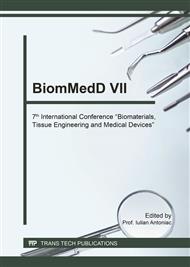p.3
p.11
p.18
p.24
p.29
p.35
p.41
p.49
Finite Element Analysis of Mechanical Behavior of Restored Maxillary and Mandibular Deciduous Incisors
Abstract:
The management of traumatic dental caries in primary teeth has the main objective to avoid their consequences that can affect the immediate and longterm quality of life of the child. Aggressive forms of decays can develop on smooth surfaces of teeth and progress rapidly, the effect being detrimental on the dentition. The objective of this study was to compare the stress and displacement distributions in the models of two assemblies by means of the three-dimensional finite element analysis: deciduous maxillary lateral incisor - restorative filling – bone structure and deciduous mandibular lateral incisor – restorative filling – bone structure respectively. Both models were subjected to a 120 N static load applied on the upper surface. The models were built from computed-tomography scans. Two different restorative dental materials were considered. In addition, the results obtained were compared with previous research of the authors, i.e. the mechanical behavior of a deciduous restored molar and deciduous restored canine respectively. As a result of the study, it can be concluded that the biomechanical analysis of deciduous dental caries is a valuable aid in enabling the dentist to make correct and effective treatment decisions.
Info:
Periodical:
Pages:
11-17
Citation:
Online since:
August 2017
Authors:
Keywords:
Price:
Сopyright:
© 2017 Trans Tech Publications Ltd. All Rights Reserved
Share:
Citation:


